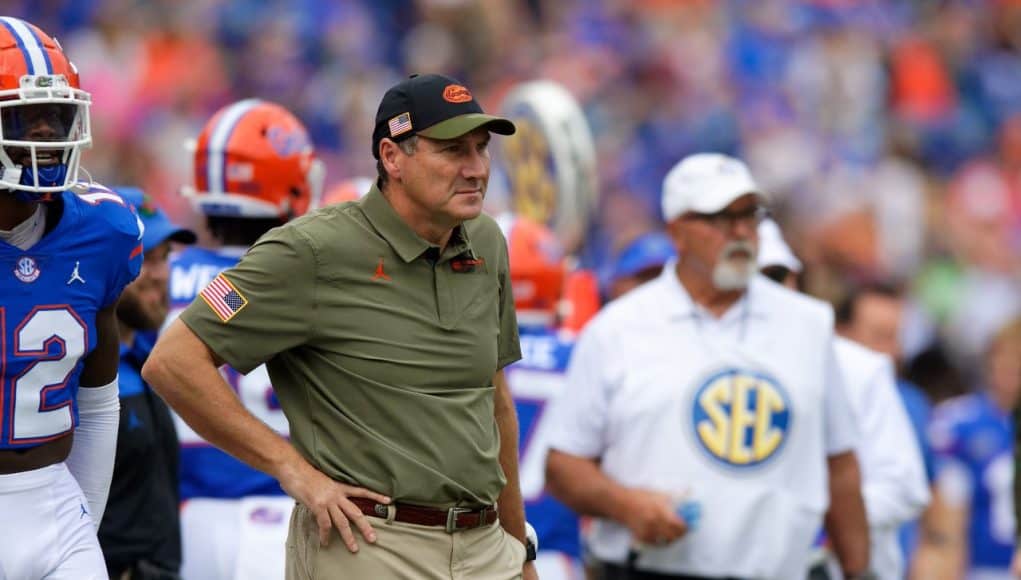Dan Mullen’s job status appears to be in flux. I don’t have any sources to report things from, but no one would be shocked at this point if he got fired after losing one or both of the Gators’ final two games.
It should also shock no one if he comes back next year, as coaches routinely get an opportunity to fire assistants to get one more chance. With there being questions surrounding AD Scott Stricklin’s future at UF after his mismanagement of Cameron Newbauer and the women’s basketball program, there is even more room for uncertainty.
The list of issues that Mullen needs to address if he sticks around is not short. One sticks out far above the rest: recruiting.
It’s not just because the the 2022 class is lagging Florida’s typical performance on the trail. It’s currently ranked 23rd nationally in the 247 Sports Composite, right below South Carolina and Georgia Tech and just ahead of Iowa State and Rutgers. It’s ninth in the SEC, and the average player rank is below all of Mullen’s other classes.
It’s because college football is in a phase where talent is largely winning out over scheme.
You can always find places where results lag talent ratings. That’s currently the case at LSU, USC, Texas, Miami, and, well, Florida. And there are always a handful of coaches who can outperform their talent ratings with distinctive schemes, like Mike Leach and his pure Air Raid or Jamey Chadwell with his triple option-inspired attack at Coastal Carolina. At the top of the sport, however, the recruiting juggernauts are reigning.
You’ve probably heard a million times that football is cyclical. Teams that lead the way into new cycles have an inherent advantage.
The death of option football everywhere outside Nebraska in the ’80s led to the prominence of pro-style run-and-defense squads. That opened the door for Steve Spurrier to revolutionize football in the SEC with his dynamic passing attack. Spread schemes brought the option back in the early 2000s. Urban Meyer’s 2004 Utah team made everyone finally realize that spread option was the next big thing, as it won every game by 14 points and had the national coach of the year and a Heisman finalist on board. Rich Rodriguez took West Virginia to three straight top-ten finishes beginning in ’05, and Meyer won national titles in 2006 and 2008.
The decade from about 2004-2013 was the era when spread schemes of all kinds from the Meyer-style option attacks to the very simple pass attack at Baylor that spread the field literally as wide as is possible. That was a time when Chip Kelly could take Oregon to the national title game in 2010 while sporting a four-year recruiting average of 18.75 according to Rivals, and everyone thought the other team in the game was the flukey performer.
Era definitions are always fuzzy, but that time was when Dan Mullen rose to prominence as quarterbacks coach at Utah, offensive coordinator at Florida, and head coach at Mississippi State.
I marked 2014 as the beginning of a new era because that’s when Nick Saban hired Lane Kiffin to run his offense. One of the most successful run-and-defense coaches gave in and decided to ride the new wave of offense.
The first few years from 2014 to around 2016 or ’17 were a transitional time. RPOs gave scheme-first coaches a little more life, and it wasn’t an overnight transition in Tuscaloosa. However 2014 was the first time in four seasons that manball purveyor Les Miles failed to win at least ten games, and he was out of a job early in 2016. Michigan State managed to go to the Playoff in 2015 with a strong defense and merely adequate offense, but no one has made it quite in that same way since.
The big powers have subsumed all of the spread’s tricks. What comes after the spread is unclear. I don’t expect Mullen to be the one to come up with the post-spread revolution given how integral spread principles are to the way he coaches. If anything, his offense this year went backwards in development since it leaned on the kinds of things he was doing ten years ago more so than the new stuff he put in the past couple of years.
But while offenses are still ahead of defenses, there are no attacks that are so schematically unique anymore that they can lift up a team that averages a recruiting ranking in the teens to true national contention. At least not without a future high first-round draft pick at quarterback as Clemson pulled off on its way up. You could make the Playoff if you’re Notre Dame with its non-elite recruiting rankings and go undefeated without playing a gauntlet of a schedule, but you’ll probably get blown out once you get there.
Mullen needs to realize the cyclical sport of college football is in a new cycle. He can scheme a win against Georgia in 2020 when the Bulldogs are caught without a good quarterback and have several key defensive players out. That’s not a consistent path to victory.
It’s more representative to see how his game plans can consistently almost beat Alabama. If he’s content to almost beat the top teams, that’s not going to end well. Florida fans are very much not content to almost beat anyone.
A team that has a ton of great players will succeed in any era, but there are times when strategic innovations can gain disproportionate ground against superior talent. Mullen climbed the ranks in such an era, but that era has ended.
College football is now in a phase where talent reigns supreme, and no one, not even the actual football genius Dan Mullen, can use Xs and Os to make up a substantial talent gap anymore. Not participating in the recruiting arms race is not an option.



Excellent article.